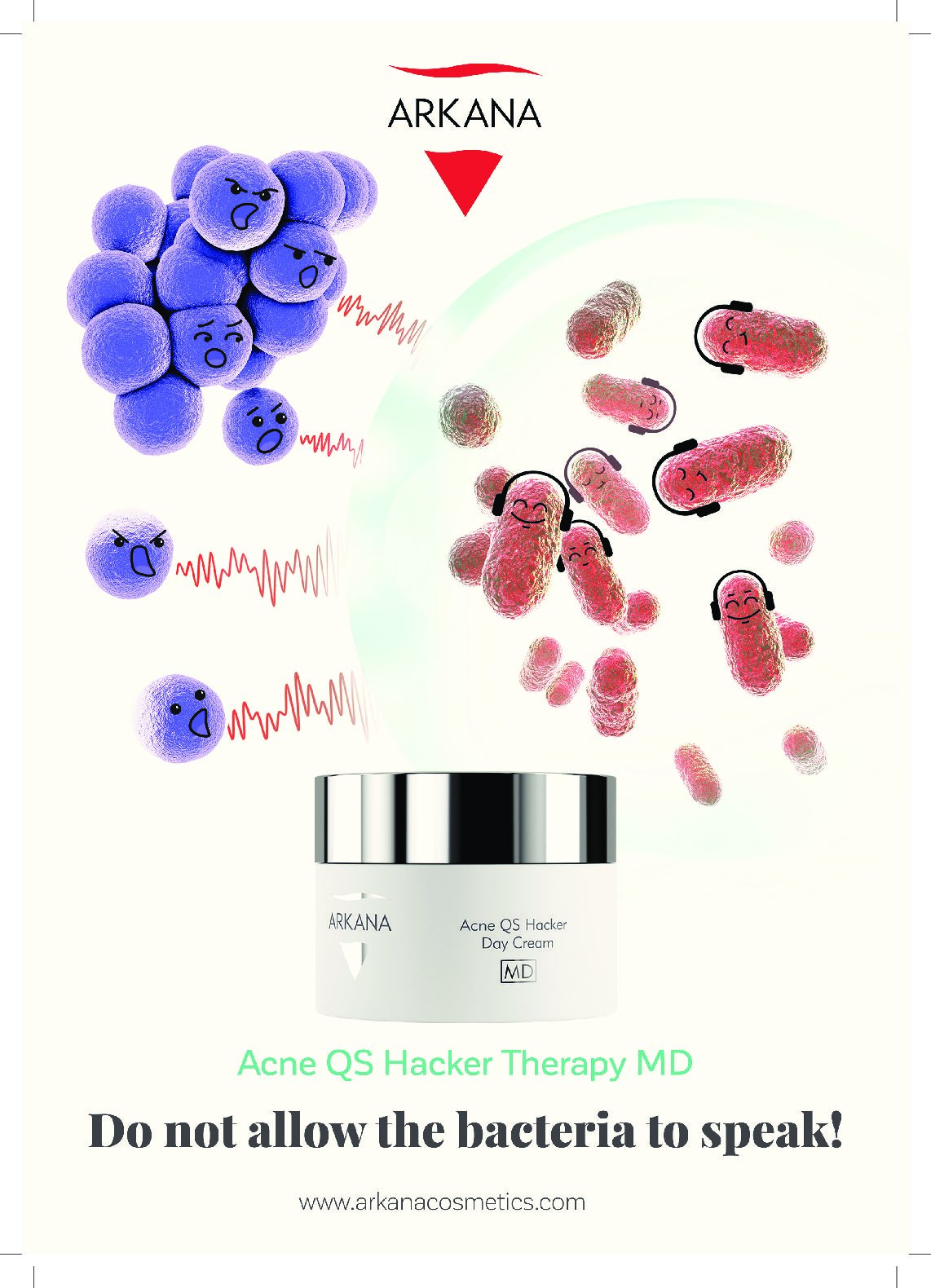
ACNE OS HACKER THREAPY
The skin traditionally consists of 3 layers. What receives more and more attention in publications is Suprastratum™ – a kind of layer consisting not only of an emulsion that is a combination of sebum and sweat (hydro-lipid coat), but also of living microorganisms (microbiota). There is also a gas layer on the skin’s surface and all of this forms a skin micro environment.
Skin microbiome consists of commensal, i.e. “good” and pathogenic, i.e. “bad” micro-organisms. The balance between them is crucial in maintaining
healthy skin. Normal microbiome is very diverse. The most important bacteria is Staphylococcus epidermidis, which protects against pathogens. The
most numerous one is Propionibacterium acnes, because its number depends on the amount of sebum produced and it plays an important role in
the development of acne lesions. Malassezia furfur, a yeast-like fungus, is also present in the microbiome of healthy skin, which can cause seborrhoeic
dermatitis and dandruff in favourable conditions. Microbiome not only protects against pathogens, but is also responsible for the immunological processes in the skin and for susceptibility to lesions and infections. The ideal state is a balance between commensal and pathogenic bacteria.
QS – a mysterious “communicator”
The newest research on acne has shown one more relevant mechanism that has an influence on the development of acne. It turns out that the micro-organisms communicate with each other. It is a sophisticated communication system established thanks to the special compounds that they produce,
i.e. quormones. Quorum Sensing (QS) is an invisible and inaudible “live chat” of bacteria, which sense the local amount of quormones through
special receptors. Bacteria are not able to do harm when in a safe amount and in the right proportion. Only after reaching a certain number (the so-called quormones) do they unite and attack when they are ready. P. acnesbacteria play a key role in this process. They use their “own language” to increase their number and colonize the skin. S. aureus is also involved in this process and they have a double influence on the amount of S. epidermidis bacteria. The next step in the inflammatory process is the breakdown of triglycerides contained in sebum into free fatty acids, which act as irritants, aggravate follicular keratosis and disrupt the pH of the skin. Then, TLR receptors are activated on the skin cells and the production
of inflammatory factors in acne increases.
A peaceful solution to acne
The previous approach to acne was based on fighting and eliminating bacteria that cause acne. As a result, skin microbiome was disturbed. On the
basis of new discoveries, Arkana offers a peaceful solution in the prevention and care of acne-prone skin. The new line Acne QS Hacker Therapy MD
is a specially designed dermocosmetic therapy regulating skin microbiome and combating the causes of acne. It is based on an intelligent mechanism blocking the communication systemamong bacteria – Qurorum Sensing (QS). Nature was an inspiration in creating this blocking system. It was observed that plants have their own system that protects them against the invasion of pathogenic fungi, bacteria and insects. Noni
(Moringa citrifolia), found in Hawaii, Indonesia and Australia, a plant which likes extreme conditions, came under observation and detailed research.
It grows in infertile areas, in an acidified or alkaline environment, on coral atolls, post-volcanic areas and is the only plant that has managed to
colonize such unfavourable areas to live. It is best known in traditional medicine in the Pacific area, including skin diseases, but also as an anti-inflammatory, analgesic, and immune-enhancing agent. Researchers have noticed that this unique plant produces its own anti-quormones – substances that protect it against “invaders”. The most vital discovery for biotechnology was that it couldbe used as a peaceful solution to the problems of acne-prone skin. The active ingredient Quora Noni PRCF created in the laboratory is a new intelligent substance affecting human skin microbiome. PRCF is a plasma rich cell factor. A unique cell plasma containing growth factors (phytopeptides) derived from Noni stem cells. They are
rich in anti-quormones and designed to be dermo- hackers of communication among bacteria. Quora Noni PRCF is a sophisticated, intelligent strategy that respects the natural micro environment of the skin. This is an effective way to block signals that are sent by bacteria, but without eliminating them.
Quickly and effectively
Acne QS Hacker dermocosmetics are the first preparations of this type that actively affect acne- prone skin microbiome. These are dermocosmetics
which are biocompatible with our skin and used for special tasks as they work quickly and effectively, both in preventing the development of acne
lesions and the reduction of the existing ones. Home care treatments and cosmetics are dedicated to acne- prone skin of any age, both for teenagers and adults. The innovative nature of Acne QS Hacker therapy is based on non-invasive interference in one of the most common problems at a beauty salon. A care plan will help to avoid more aggressive treatments. It will also serve as an active support during general and local therapies, in retinol-based treatment, chemical peels and antibiotics.
The effects of Quora Noni PRCF Therapy
Research on the Quora Noni PRCF component has shown bacteriostatic, antifungal and anti-inflammatory properties. The level of sebum, the number
of P. acnes, S. aureus, S. epidermidisbacteria and dermatological assessment of acne lesions have been examined on the group of 20 people aged
12-29. They tested preparations with 1% of Quora Noni twice a day for 30 days. The amount of serum was reduced by as much as up to 62%. The level
of S. aureusdecreased by 54% on average and of P. acnesby 50%. The number of enlarged pores and their size have been reduced by 48% on average,
and in some cases even up to 92%. Dermatologistsalso assessed the number of open blackheads, which dropped by up to 80%.

